A few weeks ago, we looked at the MikroTik CRS305-1G-4S+IN a 4-port SFP+ switch. Now it is time for our MikroTik CRS309-1G-8S+IN review which is an 8-port SFP+ switch from the company. For many of our users, the CRS309-1G-8S+IN is going to be the more practical option in this space. With a $269 MSRP and a sub $230 street price, the four additional SFP+ 10GbE ports work out to only around $25 per port more than the CRS305. In our review, we are going to check out the features of this switch and what you gain and give up by upgrading from its smaller sibling.
MikroTik CRS309-1G-8S+IN Overview
The Mikrotik CRS309-1G-8S+IN has an “IN” instead of the “RM” suffix. This denotes that it is a desktop chassis. Still, our unit arrived with a rackmount kit. Officially the size of the unit is 272 x 158 x 44 mm (10.7 x 6.2 x 1.73 in) and one can use rubber feet to mount the unit on a desk.
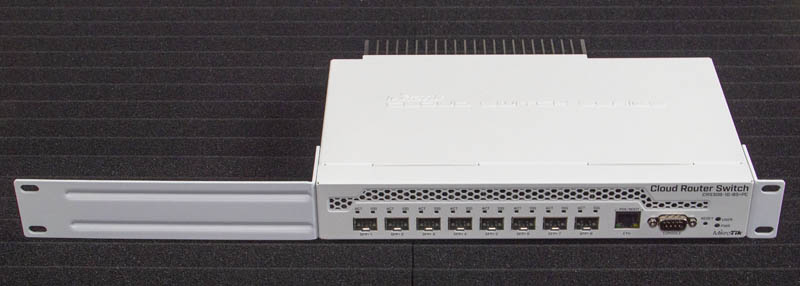
Looking at the front, the primary feature here is an array of 8x SFP+ 10GbE ports. We have not found the unit to be picky with optics and DACs, unlike our Ubiquiti EdgeSwitch ES-16-XG. In this price range, an 8x 10GbE switch is virtually unheard of. MikroTik sells reasonably priced SFP and SFP+ optics and you can find their compatibility list with this unit here.
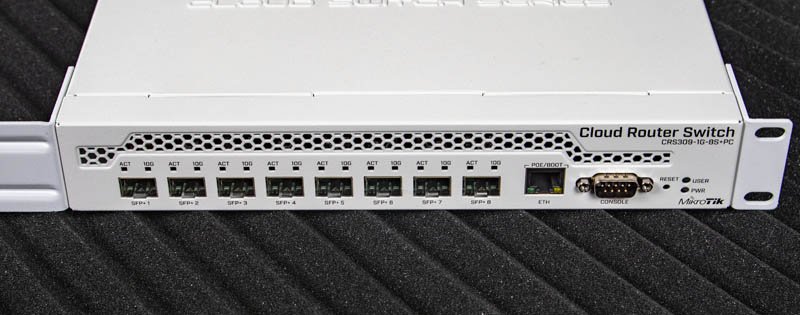
On the right side of the switch, we can see a 1GbE port, console port, a recessed reset button, and status LEDs. That 1GbE port we generally suggest using as a management port since MikroTik has a variety of inexpensive 1GbE switches with SFP+ ports. It also allows one to have a simpler setup from a security standpoint especially if one does not want to use a relatively ancient serial console port.
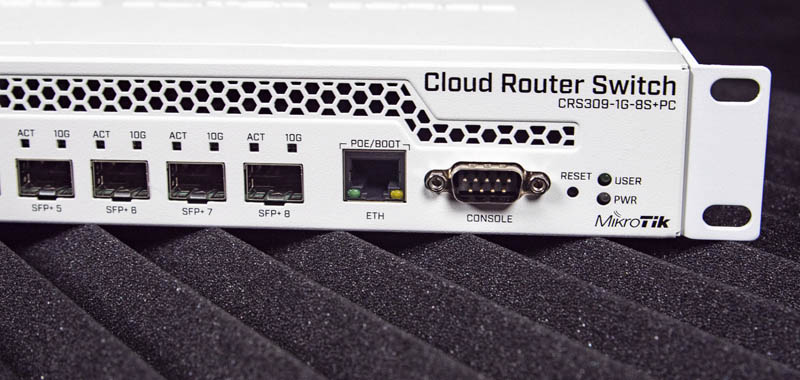
That 1GbE port has one other great feature: it can provide power via PoE (802.3af/at 18-57V) input. In this chassis, that also means one can have all cabling for the unit on the front with nothing that needs to be accessed from the rear, including power. More on power later in this review.
You will notice we have the rackmount kit installed. Our unit came with a rackmount kit. Since it is under 11 inches wide, it is not wide enough for a typical 19-inch rack. As such, MikroTik has one standard rack ear on the right side with a giant rack ear on the left. We call it “the arm.” This is a bit of a dramatic naming since it is also a common way that various vendors mount narrower components into a rack. It would have been very interesting to see MikroTik get this switch 15-20% narrower as that would have allowed half-width mounting for two switches in 1U.
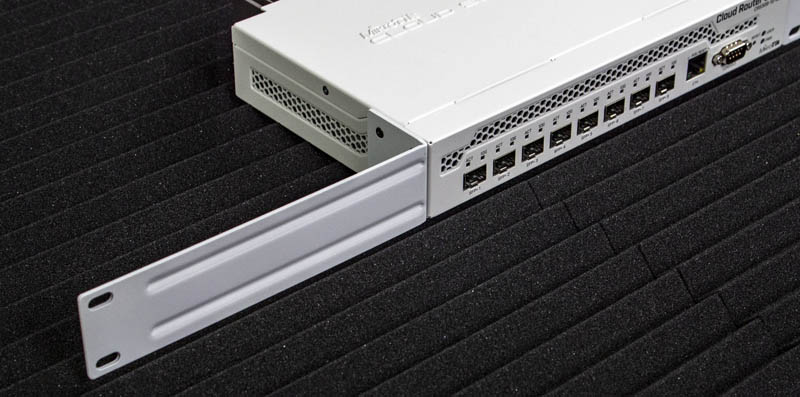
The rear of the switch is fairly simple. We are going to take a look at that next.
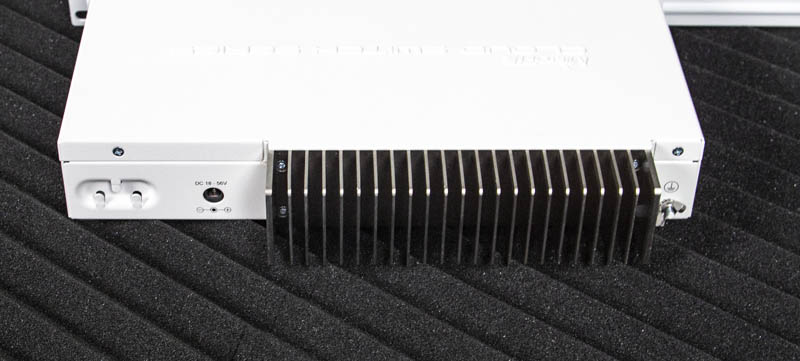
Perhaps the most common way to power the unit is via a DC input. MikroTik has one of these at the rear. MikroTik also includes one of its most common design elements, a set of three teeth that help secure the DC input cable to prevent accidental removal. We still prefer internal power supplies, but you will see from the interior of the chassis that there is little room for that feature. An internal power supply also generates heat inside the chassis which may have made it difficult to keep passively cooled.
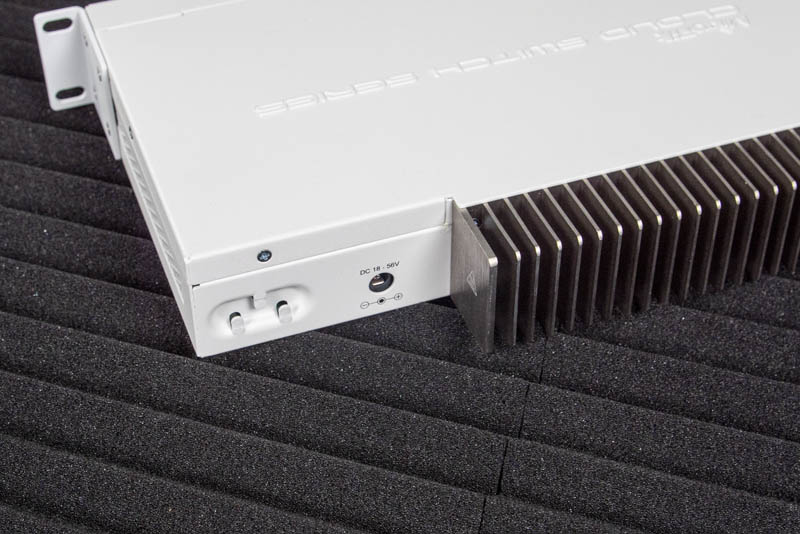
Although it only has one DC input, technically this is a dual power input switch since there is a PoE option as well. Most switches from other vendors in the sub $500 price range only have a single power input.
Outside of the back of the chassis, one can see a massive heatsink. This heatsink does get warm during operation. As a result, we suggest ensuring there is appropriate clearance around the heatsink. If you are mounting it on a desk, ensure it is not covered by papers as an example.
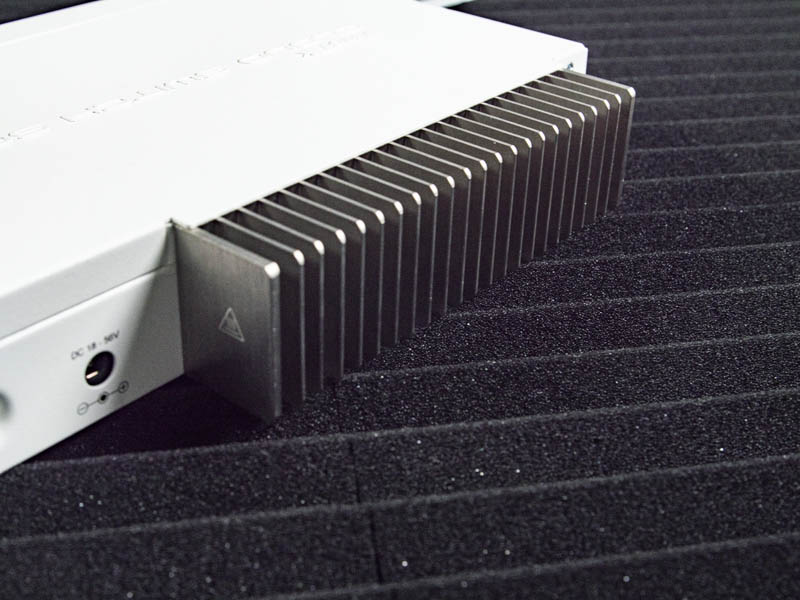
Looking inside the chassis, we can see the eight SFP cages and the large cooling solution. The CPU is an 800MHz 32-bit 98DX8208 Arm CPU with 512MB of RAM. Again, as a hallmark of the CRS line, this is not something you want to be doing routing or high-end packet filtering on. These switches are designed to be low cost and low power so you sacrifice Layer 3 switch feature performance.
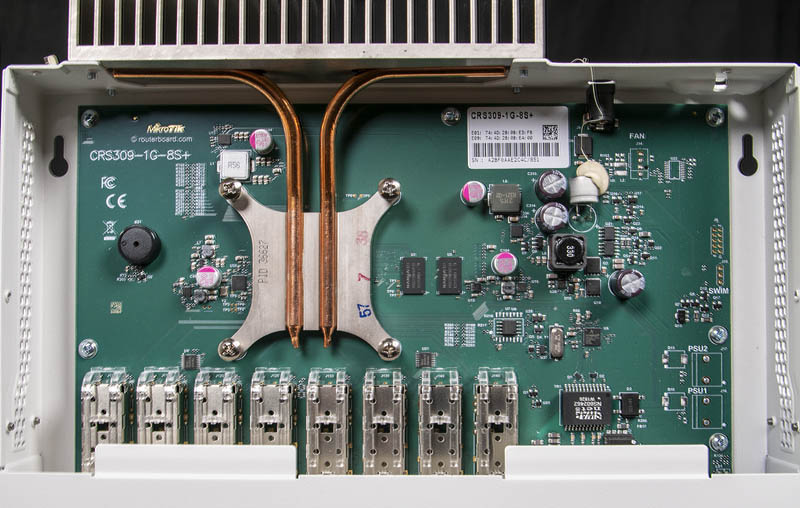
As a quick note here, if you look on the right of the motherboard, you will see the PCB has labeled but not placed component headers. There is one for a 4-pin fan near the top of this picture. There are also two sets of pads for “PSU1 and PSU2” which suggest MikroTik could use this same motherboard PCB, place fans and power supply headers, and turn this into a design with redundant internal power supplies.
The MikroTik CRS309-1G-8S+IN is a passively cooled switch. There are no fans and as a result, the switch is silent. It also lowers the power consumption of the switch.
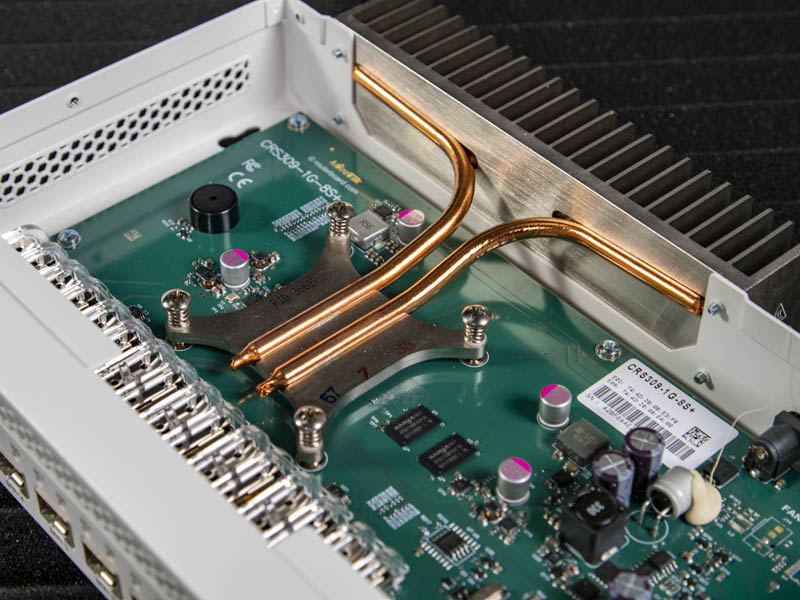
Cooling the switch one can see a dual heat pipe cooler that is connected to a large heatsink in the rear of the unit that we showed from our external view. This heatsink also forms the rear of the chassis and is screwed into the chassis itself.
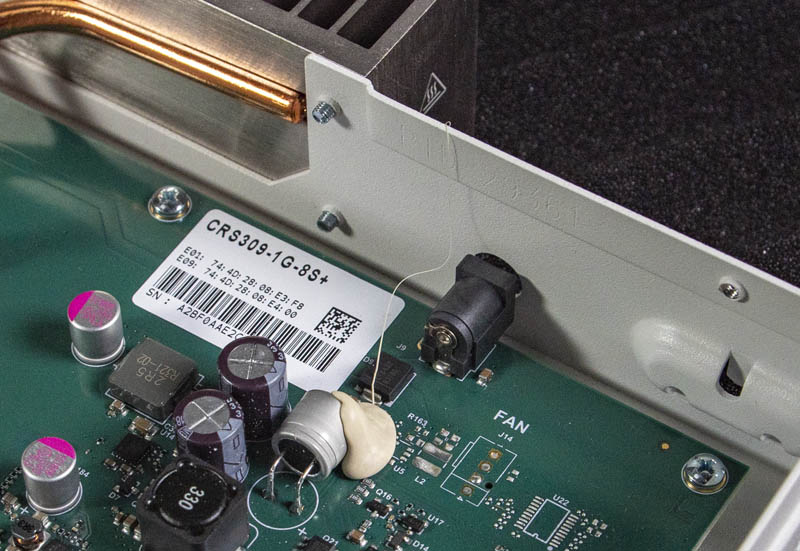
Let us be clear, this is still a $270 MSRP and around $230 street price switch. The MikroTik CRS309-1G-8S+IN shows this a bit with manufacturing features as can be seen above. Here we have a big spot of glue holding down a capacitor. That glue has a string that extends all the way to the top rear edge of the chassis. This does not impact performance, but it is also not something we tend to see on our lab’s $10,000 100GbE switches. At this price point, this is fine. We just saw this while opening the switch and thought it is a good reminder.
You can check out the STH MikroTik CRS309-1G-8S+IN overview and unboxing video on YouTube here:
That video shows off the unit without the rack ears that we used in photos for this review.
When to Use These Switches
We think that the MikroTik CRS309-1G-8S+IN is a great option for connecting multiple 10GbE devices including desktops, NAS units, and even other switches. These can be MikroTik CRS312-4C+8XG-RM 12-Port 10GbE Switch Review for 10Gbase-T and additional SFP+ ports. It can also include a 1GbE switch like a MikroTik CSS326-24G-2S+RM to get 1GbE networking on your network.
As a plus, the MikroTik products run RouterOS standard which has a number of features. The Marvell 32-bit Arm processor is not going to run an enormous number of services, but you will see a lot of L3 services available. There is also a SwOS which is a more stripped-down OS designed for switches.
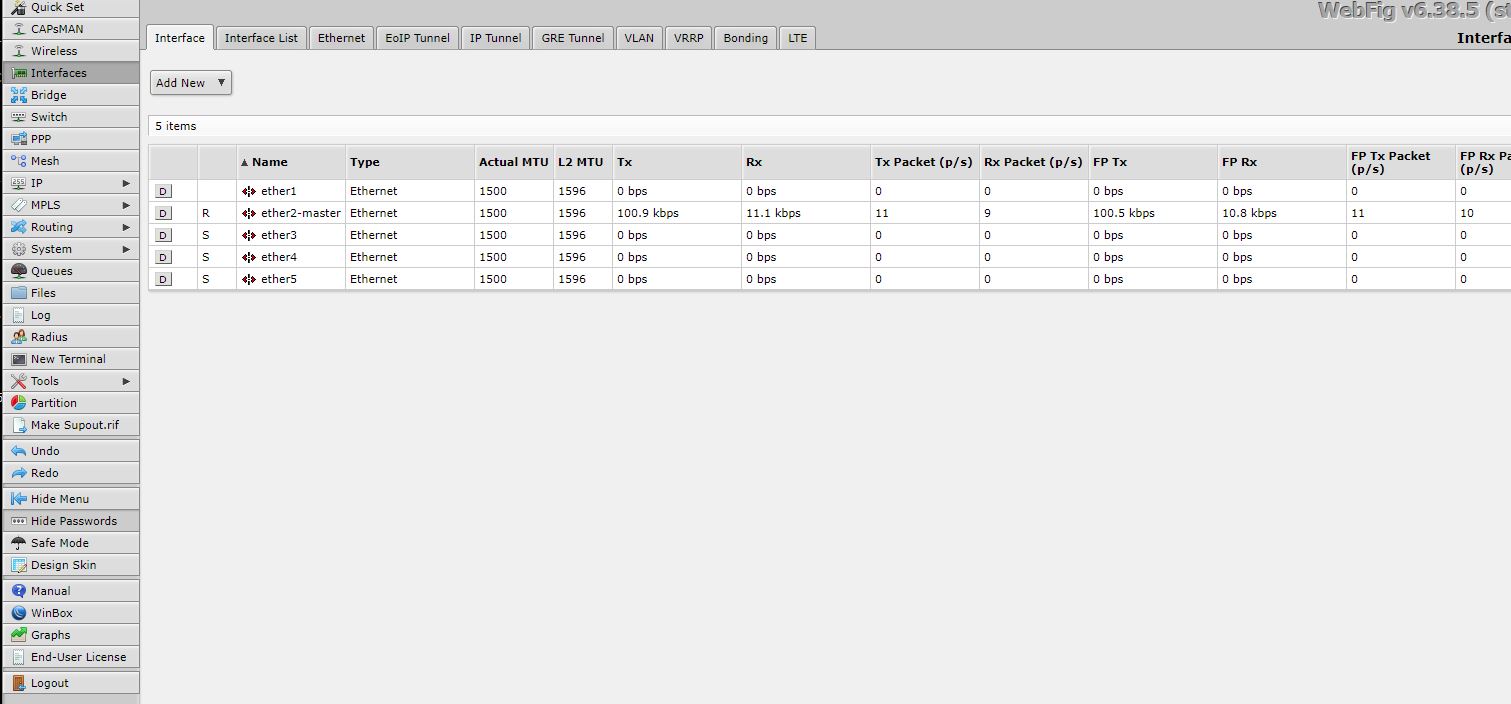
In either case, you can use GUIs like the WebFig or WinBox to manage your devices. If you are a novice but need to set up a VLAN, this is much easier than learning a new CLI to make a set-and-forget style configuration.
As with any device, ensure you change your passwords and put the management port onto a secure management network.
The Counterpoint: MikroTik CRS305-1G-8S+IN
For an 8x SFP+ 10GbE switch around $229, the switch does not have any direct price competitive parallels. Instead, perhaps the bigger question is the MikroTik CRS305-1G-4S+IN which is a four-port switch. To us, if you do not need 5-8 ports, the CRS305 is the way to go. If you do need a larger switch port capacity then the CRS309 is the better option.
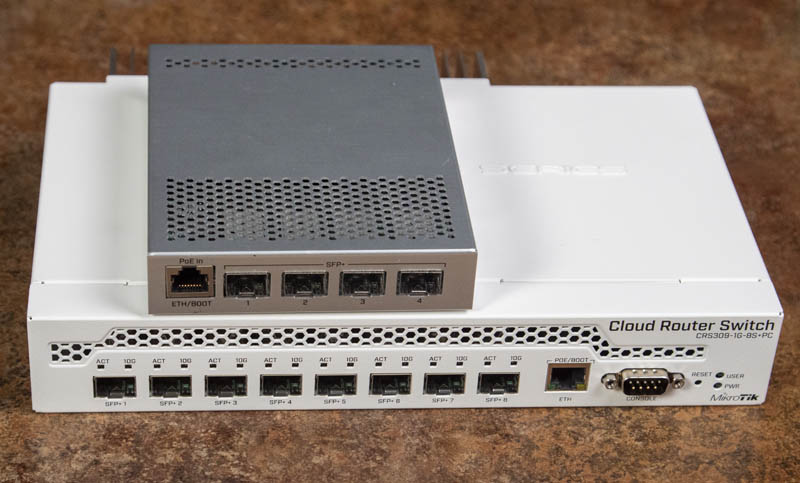
There is also a great point to be made to simply upgrade to the CRS309-1G-8S+IN and skipping the lower-cost unit. If you are at four ports of SFP+ today, having more capacity upfront is easier than adding it later. Power consumption is slightly higher, but when we are looking at less than 5W deltas in our testing, we think that is OK.
MikroTik also makes SFP+ to 10Gbase-T converters (S+RJ10) which sell for around $70 each. If you are using PoE power with the CRS309-1G-8S+IN, you can only use four of the S+RJ10 units with 24V PoE input. If you have 30V+ PoE input, you can use up to eight. Still, we think the larger 8-port switch gives one the flexibility to build around SFP+ then add a port or two of 10Gbase-T if absolutely necessary.
A Note on Performance
We typically use these for fairly simple networking either with flat networks or using some VLANs but without routing. Since our typical network usage is file transfers, we generally get line rate minus overheads when we pass traffic over 10GbE. If you need highly specialized networking or the lowest latency switch, you probably are not looking at the $230 price bracket. For its intended use, it is fine. Here are the official switching results from MikroTik:
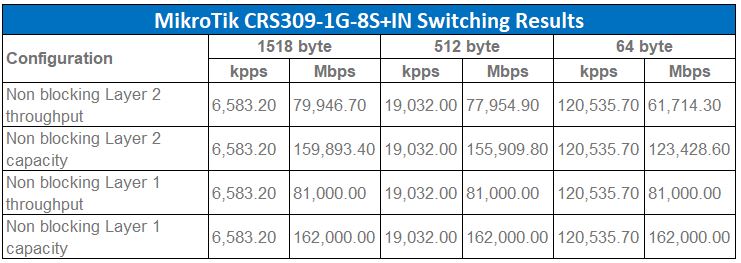

Key here is that performance as a simple L1/L2 switch is around line rate. Adding features means that the switch starts to quickly reach saturation points. Our advice: think of this as a simple L1/L2 switch.
Power Consumption
We tested power consumption on 120V power since that is common at the edge where these will be deployed in North America. In terms of actual power consumption we saw:
- Idle Power: 12W
- Max Observed Power: 20W
- Max Power from Spec Sheet: 23W
This is minimal overhead for using a switch instead of a direct-attach setup.
Final Words
MikroTik has something really innovative with the CRS line. It is a big reason that the MikroTik CRS305-1G-4S+IN won one of the rare STH Editors Choice Award. Let us be clear, if you think of this as a switch that you will plug in, power up, and just let traffic flow through, you will not be disappointed with an 8-port SFP+ switch around $230. If you want to play with routing, IP filters, and other features, the Arm CPU simply cannot handle it.
Build quality is OK, but you can see a few trade-offs that have been made to keep costs low. At $1,000 we would be concerned, at $230 and with our switches running fine for a few months, we think the trade-offs are reasonable.
The company did a great job building a low power and silent switch that can be deployed just about anywhere. Combined with other CRS switches these devices can make higher-end networking accessible to deployments that previously would have spent 2-3 times as much, and potentially had to deal with noise.
So long as you understand what this switch was designed to do, we think it is an absolutely great buy.

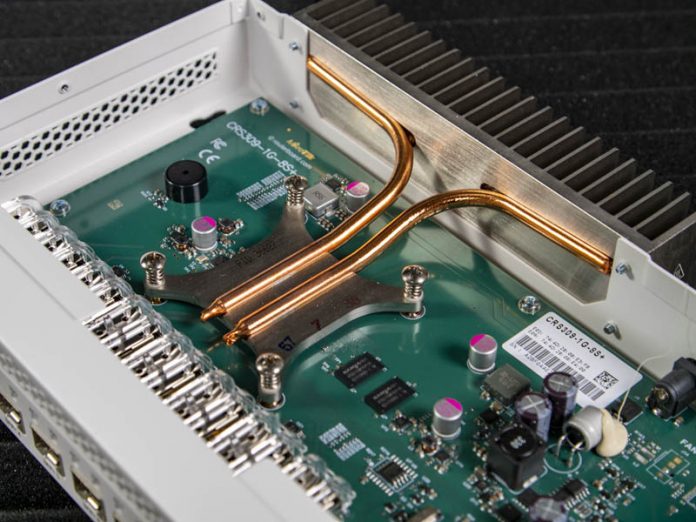



I’m actually running two of these at work for our production vSphere environment as storage switches. Currently they have 4 ports populated with 1 more each to populate in the near future. In this environment they work great for us. The bottleneck is our NAS, but even so it is faster than the internal storage was in the prior environment. I’d get one for home, but alas I need more 1GbE ports at home than 10GbE ports.
Am disappointed that MikroTik didn’t spend a little more thought to the physical sizing, they could have made a unit which allowed for 2 to share a single 1U rack space. The photos clearly show that they could have trimmed the unit width.
BinkyTO – True, they could have. Although given how I have them mounted in the rack I like the fact that they didn’t allow that. I have full depth shelves above and below them (one above holds old desktop PCs re-purposed as servers and the one below is used for cable management). This way they still get plenty of airflow over the heatsink to keep them from overheating.
I’m down. Just ordered one to try at home. We do a bunch of quarter cab colos and this will let us to 10G if it works
If you need 8x 10G-baseT ports, probably do not buy this. The Mikrotik docs state that if you populate adjacent SFP cages with those transceivers, you need to somehow provide additional cooling to the SFP cages, or you risk overheating the transceivers, causing undefined behavior. Not fun.
I have found powering via PoE on the management port worked once, and has never worked again.
Trying to get support from MikroTik on this has been nigh on impossible, so just something to take note of if using in production environments.
These are amazing for home lab. Forget the 1gbe switches. Go directly with 10gbe. Also small business with low budget these will make a huge impact. I installed a 10gbe switch from eBay second hand for an sbs to use for data transfer between heavy duty cad/graphics stations. What a difference it made. At the time I wish I had an option to get these.
I got one of these in early 2021 and interestingly had the same problem as @Eds and the PoE port only powered up once. The second time it made an odd electrical whistling noise and that was it, it only worked off the DC input after that. I sent it back and got it replaced and the replacement unit has been working fine ever since, so it looks like there could be quality control issues. I had the retailer open the replacement box and power it up via POE a few times before they sent the unit back to me, just in case.
I have been running it with 8 DACs and powered via PoE and haven’t had any thermal issues, and I’m in the subtropics so my ambient temperatures are around 32 C (90 F) and it has coped fine. But I guess using SFPs instead of DACs could be a different story.
Hello, could you tell me which DAC model you are using on these 8 ports? please
I have been running this switch 8 with Wiitek SFP-H10GB-CU2M DACs for well over a year and have had no issues. While mine are 2 meter DACS, the generic Wiitek description is 10GbE SFP+ Twinax 30AWG @M (for 2 meter) CIS.
STH team – you are probably aware the since your review, Mikrotik upgraded RouterOS to allow offloading of certain L3 features like VLANs to the switch chip rather than CPU, enabling line rating intra-VLAB routing. The same also applies to the CRS305 you reviewed (and other switches I don’t happen to own).
Would love to see a comment or perhaps a standalone review on your thoughts on this – these devices are already stellar for home labs and solving this weakness retrospectively was a very pleasant surprise from MT!